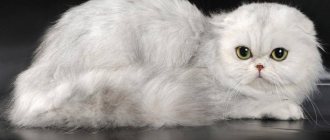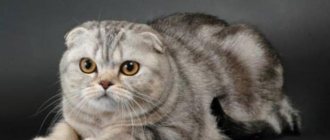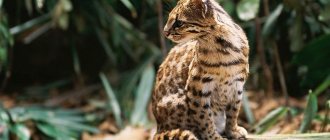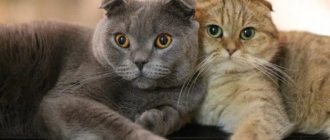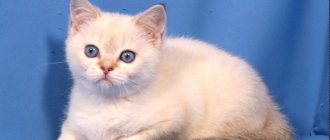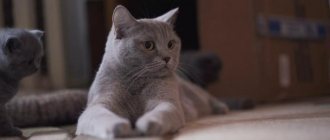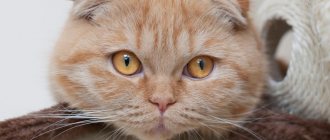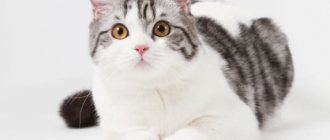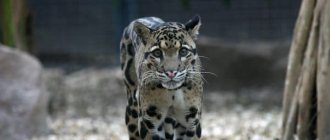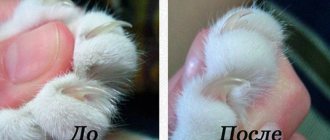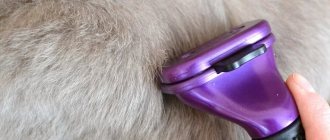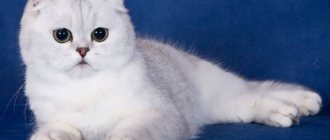Highland Straight: history of the breed
The history of the Highland Straights (more precisely, their direct ancestors) begins in the 60s in Scotland. It was then that a cat named Susie was found - the first Scottish Fold cat. One of her kittens, Snooks, who inherited the lying ear mutation, was taken for breeding by breeders Mary and William Ross.
This is the starting point in the origin of the Scottish Fold and Scottish Straight breeds (Scottish Fold and Straight), inseparable from the Highland Straight. Mary and William crossed Snooks with British Shorthairs. The resulting litter (which included both straight-eared and lop-eared cats) was also crossed with Persian and Himalayan cats. The resulting type of semi-longhaired cat was called Highland. They were divided, like the Scottish, into straight-eared and fold-eared.
An open, curious look is the calling card of all Scottish cats.
The breed was recognized in the 1980s by the TICA organization. The Highland Straight is part of a group of Scottish breeds that also includes the Scottish Fold, Scottish Straight and Highland Fold.
Description
The graceful Scottish Straight has several features in its appearance that are characteristic only of this breed. Yes, the description of the standard for straight-eared cats differs little from Scottish ones, but dry facts are not always objective.
It is hardly possible to convey the feeling of foamy silkiness in your hands and trusting surprise in your eyes. In addition, the overall stockiness of the figure of these cats is transformed into a graceful and flowing silhouette due to the fluffy long hair.
The Highland Fold Standard assumes that a purebred representative of the breed will meet the following description:
- body. The sizes are average. The weight of an adult cat is up to 5 kg. Cats are a little smaller. The body is large. Short legs make this breed stocky, but do not diminish its grace. The cat has a developed muscular constitution, a short and powerful neck. The tail is usually of medium proportions and not long;
- head. The breed has a rounded head with prominent, full cheeks. Well formed lower jaw; not protruding, but noticeable chin. The nose is straight and fairly wide. The vibrissae pads are clearly visible on the cat's face;
- ears. Heavily pubescent outside and inside. Set wide apart, small and graceful, distinguished by a wide base and neatly pointed tips. Must be straight, otherwise the animal will be rejected;
- eyes. Round and large, quite widely spaced. Slanting is excluded. Eyes can be of any color, provided they are in harmonious combination with the natural color of the cat;
- wool. A distinctive feature of the Highland Straight is its luxurious silky coat. The average length of the guard hairs corresponds to the height of the dense undercoat. The structure gives the fur additional volume; in the light it is glossy and does not cling. Cat colors are acceptable in any variations and combinations.
The straight-eared long-haired Scottish is a desirable pair for mating with the Highland and Scottish Folds. Such unions improve blood health and prevent irreversible degeneration of the gene pool of these cat breeds.
In the offspring of such couples, kittens are born with both straight and curved ears. This does not appear immediately - only in the 3rd week. In addition, long-haired and short-haired kittens can appear in one litter in all the variety of colors inherent in the breed.
Breed standard
The Highland Straight is essentially a straight-eared, long-haired version of the famous Scottish Fold. In terms of body structure, they are practically indistinguishable and belong to the same breed group. Highland Straights are medium to large-sized cats (from 4 to 7 kg) with semi-long hair, massive and muscular.
The standard includes the following provisions:
- Head: Round shape.
- The cheeks are prominent and full. They make the muzzle look thick, while the overall expression of the muzzle is soft, gentle, open and curious.
- The ears are small or medium-sized, wide. They should be placed on the head like “caps”, emphasizing the rounded skull. Under no circumstances should they be placed high or close. The size of the ear is not as important as the set and fit. The tips are rounded.
- The eyes are wide open, large and round, with a sweet, curious expression. Eye color should be in harmony with the coat.
- The chin is moderate.
- The muzzle is moderately wide with softly rounded whisker pads.
- The nose is short and wide.
- The profile shows the soft graceful curve of the nose. Let's allow a sharp transition from the forehead to the nose.
- The neck is short, muscular, and rather thick.
- The torso should not be very long, with soft rounded contours.
- The tufts between the toes, tassels and fur on the ears should be visible.
- heavy eyebrows hanging over the eyes, making the cat’s gaze frown;
- obvious pain, feeling unwell;
Photo gallery: Highland Straight colors
White Highland Straights look like sweet angels
Highland straights of black solid color do not bring bad luck at all
The golden color of the Highlands is the “heritage” of the British breed
The color of the chinchilla is silver with blackened tips of the hairs (tipping)
Chocolate Highland Straights can only have yellow eyes
The name of the color “cinnamon” translates as “cinnamon”
Red, or red, color is one of the brightest
Tortoiseshell color occurs in females in 99% of cases
In Harlequin bicolor colors, spots are randomly scattered across the cat’s body on a white background
Van bicolor color covers only the top of the head and tail, leaving everything else white
Color point colors were inherited from Highland cats from Himalayan cats.
Tabby is a pattern in the form of stripes, spots or marbled “stains” on any color
Tabby colors with white look impressive
Smoky colors are rare among Highlands
Feeding
The high adaptability of cats to different conditions made Highland Folds absolutely unpretentious to food. They eat whatever is offered: canned food, natural or dry. But breeders recommend sticking to a natural diet. At the same time, it is necessary to monitor the variety, completeness and balance of the diet.
A representative of the Highland Fold breed will need frozen meat, fish, cereals, vegetables, vegetable oil and dairy products. It is absolutely unacceptable to feed cats human food. Periodically it is necessary to supplement the diet with vitamins and minerals. This is especially true when it comes to molting. The purebred Highland Fold, curious and sociable, looks at the world with wide open eyes, which are in touching harmony with his ears pressed to his head and a fluffy cloud of fur. Such a pet will not throw a tantrum and will not make a scandal. The positivity emanating from a cat will cope with any stress in the owner’s life.
Highland straight character
Highland Straights are intelligent and inquisitive cats. They are very friendly towards their family. As a rule, these cats do not hide around the house and are not shy - on the contrary, they always follow their household members from room to room like a tail.
This breed is called four on the floor kitties by breeders and show judges (translated from English as “a cat with all four paws standing on the ground”). That is, Highlands will always be next to you, but at the same time they will “stand firmly on the floor” - they do not like being picked up too much, depriving them of reliable support. They also do not like idleness - they are always busy with something.
Highland Straights are smart and curious cats
The intelligence and curiosity of the Highland allows them to learn things like opening doors to look inside, turning lights on and off to understand how this strange process works. Some Highlands can be trained to fetch and fetch.
Many pets love to drink running water, which is why they learn to open the taps. A few more funny features of the breed - they often drink and eat with the help of their paws, take the pose of hunting dogs when they hear unusual sounds, and look around carefully. But the cutest habit of all cats of the Scottish group is to take the “Buddha pose”, that is, sit down in human style and rest like that for hours.
This is a rather imposing and quiet breed. They are affectionate and kind, and get along well with other animals if they came into the house before the Highland Straight. If you are planning to bring another animal into a house where there is a Highland, then you need to introduce them carefully so that the cat does not get jealous. However, for those whom the Highland has accepted into his “pack”, he will become the most affectionate and devoted comrade. This active and at the same time patient breed is perfect for children of any age and large families. The main thing is not to pick up the cat too often, so that it doesn’t get scared and accidentally hurt itself and the baby.
Video: features of the long-haired straight-eared breed
How to choose a kitten
Choosing a kitten is not an easy task
You need to pay attention to the following aspects:
- appearance;
- behavior;
- health status.
When choosing a kitten, you should pay attention not only to its photo, but also to watch it in person. An important indicator is the condition of the coat: it should be shiny and smooth.
An important indicator is the condition of the coat: it should be shiny and smooth.
The tail should be mobile to the very tip, without deformed vertebrae.
It is important to observe the kitten's behavior. A healthy baby is active, playful and curious
A healthy baby is active, playful and curious.
His mood and attitude towards people are also important. If he is wild and does not make contact with people, there is a chance that his behavior will not change in his new home.
If he is wild and does not make contact with people, there is a chance that his behavior will not change in his new home.
This breed is rich in different colors
Health status
The next point is health.
There should be no discharge around the kitten's eyes or nose.
The baby itself should be strong enough and well-fed, the coat should be smooth and shiny.
A bloated tummy, dull and disheveled fur coat are signs of either a disease or poor nutrition.
You also need to make sure that the kitten does not have bad breath.
A healthy baby will smell nice of milk.
There should be no brownish coating in the ears, which may be the result of ear mites.
Conditions of detention
You need to inquire about both the condition of the kitten and the peculiarities of its maintenance.
It is worth asking the breeder about his diet.
A sudden change in diet causes health problems, so it is better to leave the menu unchanged.
You need to look where the tray is located and find out what kind of filler the breeder uses.
Social adaptation is important for kittens
Another point when choosing kittens is getting to know their parents.
After watching them, you can imagine how the kitten will most likely grow up.
You should ask the breeder about vaccinations.
If you like one of the kittens, but its vaccination has not yet been completed, you should make an advance payment for the baby and wait until he gets all the vaccinations.
This will subsequently protect your pet's health.
Maintenance and care
Highland Straight cats do not require special care. What you will need to buy for your pet:
- a bed (or, if desired, a house);
- scratching post;
- tray and filler;
- bowls for food and water (not plastic - it is better to choose ceramics or metal);
- several toys;
- necessary products and items for cat grooming and hygiene;
- feed.
Nutrition
The main thing to consider when feeding a Highland Straight is the quality of food and care for the coat. You can feed your Highland dog with natural products and food of at least premium class.
The following foods are suitable for Highland Straight:
- Royal Canin Indoor Longhair;
- 1st Choice Healthy Skin & Coat Salmon;
- Acana Grasslands;
- Go! SENSITIVITY + SHINE, Duck Recipe for Cats;
- Grandorf Adult Indoor Lamb&Rice.
Photo gallery: food for Highland Straight
Royal Canin Indoor Longhair - premium food made in France
Super-premium food 1st Choice Healthy Skin & Coat Salmon is designed specifically for long-haired cats
Acana Grasslands recognized as one of the best holistic foods in the world
Holistic food Go SENSITIVITY + SHINE, Duck Recipe for Cats cares for the digestion and health of the cat’s coat
Super premium food Grandorf Adult Indoor Lamb&Rice - complete nutrition for cats of all breeds
Natural feeding consists of the following products:
- 60% meat (lamb, beef, rabbit or poultry);
- 15% porridge (oatmeal, buckwheat, rice);
- 15% vegetables and herbs (vegetable puree from several vegetables), you can give everything except onions, potatoes, dill, parsley, celery and other herbs;
- 10% fermented milk products and cottage cheese, divided into 2-3 doses per week;
- quail eggs - 3-4 per week, given raw;
- white sea fish - about 80 g per week, divided into 4 doses.
Meat and fish should always be boiled, otherwise there is a high risk of helminth infection. The daily portion of a cat depends on its weight and is calculated using the formula 35 g per 1 kg of weight. Basic food: mix 3 parts meat with 1 part porridge and 1 part vegetable puree. The Highland Straight is fed twice a day.
What not to give to a cat:
- any food from a person’s table;
- sausages and canned goods;
- pork;
- river, red and fatty fish;
- spices, seasonings;
- sweets;
- milk.
With a natural type of food, the cat needs to be given vitamins. Excel Brever's Yeast 8 in 1 is suitable for wool, and Beaphar Irish Cal, Beaphar Top 10 Cat and Radostin from Agrovetzaschita are recognized as the best vitamin supplements.
The Highland Straight needs to take vitamins, but these should only be prescribed by a veterinarian
Grooming
The long, silky coat of the Highland Straight requires especially careful care:
- Combing. It is done once every 2-3 days, during molting - daily. For complete care you will need: antistatic spray;
- combined comb;
- rubber comb;
- combination brush;
- furminator for long-haired breeds;
- restorative spray for wool. Procedure:
- Choose a time when your cat is fed and calm.
- Start combing by spraying the wool with an antistatic agent. This way it will not become electrified, and the cat will behave much calmer.
- Then smooth the fur with a comb. If there are tangles, gently untangle them with your fingers. If the tangle does not untangle, carefully cut it off with scissors.
- Then comb the fur with a furminator. Its use should not be overused - once every 7-10 days is enough even during molting.
- Next, comb the cat with the iron side of the combination comb.
- The next step is a rubber comb. It will remove any remaining dead hair.
- Then use the bristle side of the combination brush. It gently massages the skin, increasing blood flow to the hair follicles.
- The last stage is spraying the wool with a restoring spray and final combing with a comb. The restoring spray makes the hair soft and manageable, prevents the formation of tangles and envelops the hair with a protective film. It is completely safe for cats.
- Jerob Herbal Shampoo;
Photo gallery: Highland Straight grooming accessories
Antistatic spray from Cliny is completely safe
BioGroom Anti-stat antistatic spray can be used on all long-haired animals
A combination comb straightens the coat
Combination comb is easy to use
You need to buy a rubber comb at a pet store.
Beaphar Macadamia Spray - restoring spray for cats and dogs Anju Beaute Jojoba restoring spray contains jojoba oil that is beneficial for hair
Redken Extreme Cat Restoring Spray with proteins helps make the coat manageable and silky.
"Miss Kiss" moisturizing spray with an antistatic effect has two actions at once
Do not overuse the furminator
Other care
It is also necessary to care for your cat’s eyes, ears, teeth and claws:
- Ear cleaning - once every 5 days. First, drops are placed in the ear to clean the ears. The base of the ear is massaged. Then, use a cotton swab dipped in cleaning lotion to wipe the ear. If the cat does not participate in exhibitions, it is advisable to shave the thick hair in the ears.
- The eyes are wiped daily with a natural cloth soaked in warm water. Cotton wool is not suitable - it can leave small particles in the eye that cause irritation to the cornea.
- Teeth are brushed once every 2-3 days with a toothbrush for cats and a special toothpaste.
- The claws are trimmed with a nail clipper as they grow by about 2–3 mm, doing this carefully so as not to touch the pink body of the claw. You cannot trim a claw with scissors, as this is very dangerous.
Cats' claws are very sensitive to injury, so they need to be trimmed properly.
Health of Highland Straights
Highland Straights are a much healthier breed than their Fold cousins. This is so because their genome does not contain the Fd mutant gene, which is responsible for lop ears and often carries with it diseases of the musculoskeletal system. However, these cats also have some tendencies.
Turn of the century
Entropion is a disease characteristic of Persian cats; with their genes, it was passed on to Highland Straights. This dangerous defect is the result of weakening of the ligaments and muscles associated with the eyelid, causing it to turn under. As a result, rough skin and hairs come into contact with the cornea, which leads to irritation. Sometimes the cornea becomes so damaged that the eye must be removed.
Volvulus can be either acquired (secondary) or congenital (primary).
Symptoms of the disease:
- excessive lacrimation (mild form);
- redness of the eye and profuse lacrimation (moderate form);
- You may notice ingrowth of hairs into the cornea upon careful examination (severe form).
As a rule, treatment is surgical. In kittens from 4 months of age, bloat may go away on its own by 8–10 months, but you should contact a veterinarian in any case.
Entropion of the eyelid can lead to removal of the eye
Obesity
If a Highland Straight doesn’t move much and eats a lot, then he may well become obese, as he is at risk. Obesity is considered to be 20% or more excess weight. Hormonal imbalance may also be the cause.
Symptoms of obesity:
- shortness of breath after minor activity;
- inability to feel the spine and ribs through the fat layer;
- it became difficult for the cat to jump, run and even walk;
- the cat began to look like a woolen “ball”;
- joint problems are more likely not a symptom, but a consequence of obesity.
Prevention is a proper balanced diet and lots of exercise. If your cat does get sick, contact your veterinarian. He will create an individual diet, physical activity regimen and, if necessary, prescribe hormonal medications.
Obesity is as big a problem in the cat world as it is in the human world.
Hypertrophic cardiomyopathy
Hypertrophic cardiomyopathy is a dangerous heart disease that affects many breeds. The Highlands also inherited it from the Persians. With HCM, the walls of a cat's heart become stiff and thick. The heart loses its elasticity and cannot fully supply the body with oxygen. The disease is fatal and dangerous because in the early stages, when it is still curable, it is practically invisible.
In hypertrophic cardiomyopathy, the walls of the heart thicken and it loses its ability to fully pump blood.
Symptoms:
- severe shortness of breath;
- fainting;
- “galloping” heart rhythm, arrhythmia;
- heart murmurs;
- high blood pressure (hypertension).
It is impossible to cure cardiomyopathy in the later stages. In order to notice the onset of the disease in time, you need to regularly take your cat for examination to the veterinarian.
Breeding Highland Straights
Highland straights are much easier to breed than folds, still due to the absence of the Fd mutant gene.
But before buying a cat, you need to take felinological courses and register the cattery with an organization or breed club . Only after this can you buy cats for breeding. Breed or show class cats are suitable. Highland straights ripen at 8–9 months. Both cats must participate in shows from the age of 10 months to receive breeding grades. Without them they will not be allowed to breed.
It is allowed to cross Highland Straights with British Shorthair, American Shorthair and British Longhair cats.
The first mating should take place no earlier than 1.5 years of age. Before breeding cats, you need to obtain a certificate from a club or organization. To do this, you need to provide pedigrees and breeding estimates for both cats. Without this, the litter will not be activated, and the kittens will not be considered purebred.
Highland pregnancy lasts from 60 to 65 days. Main signs of pregnancy:
- the cat is sick in the morning (she has toxicosis);
- nipples swell and turn pink;
- Appetite increases and eating preferences may change;
- character changes;
- The cat sleeps more and behaves a little apathetically.
Pregnancy becomes obvious to the naked eye only in the sixth week, but after 3 weeks it can be determined by a professional using ultrasound and palpation.
Pregnancy in Highland Straights lasts at least 2 months.
Kittens are examined by a specially appointed felinologist from a club or organization within 8 weeks after birth. Upon activation, a breeding certificate is issued for the entire litter and a metric for each kitten, which includes the name, breed, color and ancestors of the animal up to the 4th generation. If desired, the metric can be exchanged for a full pedigree.
There are certain rules in naming kittens: each new litter begins with one letter in alphabetical order (the alphabet is usually Latin, but Cyrillic is also possible). That is, the very first litter will have names starting with A, the second - with B, the third - with B or Latin C, and so on. In advance, even when registering the cattery, think about what you will call it: after all, after the kitten’s name the name of the cattery will always be written. It should not be too simple, but also not too pretentious. For example, a cattery with the name “Golden Cats” or “Favorites of the Sun” will look great, but “Cats” or “Man’s Best Friends” - not so much.
Before you start breeding cats, you need to register your cattery
